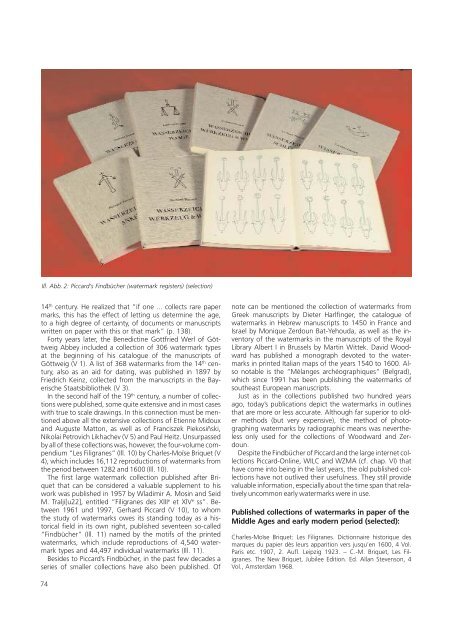Bull's Head and Mermaid - The Bernstein Project - Österreichische ...
Bull's Head and Mermaid - The Bernstein Project - Österreichische ...
Bull's Head and Mermaid - The Bernstein Project - Österreichische ...
Create successful ePaper yourself
Turn your PDF publications into a flip-book with our unique Google optimized e-Paper software.
Ill. Abb. 2: Piccard’s Findbücher (watermark registers) (selection)<br />
14 th century. He realized that “if one ... collects rare paper<br />
marks, this has the effect of letting us determine the age,<br />
to a high degree of certainty, of documents or manuscripts<br />
written on paper with this or that mark” (p. 138).<br />
Forty years later, the Benedictine Gottfried Werl of Göttweig<br />
Abbey included a collection of 306 watermark types<br />
at the beginning of his catalogue of the manuscripts of<br />
Göttweig (V 1). A list of 368 watermarks from the 14 th century,<br />
also as an aid for dating, was published in 1897 by<br />
Friedrich Keinz, collected from the manuscripts in the Bayerische<br />
Staatsbibliothek (V 3).<br />
In the second half of the 19 th century, a number of collections<br />
were published, some quite extensive <strong>and</strong> in most cases<br />
with true to scale drawings. In this connection must be mentioned<br />
above all the extensive collections of Etienne Midoux<br />
<strong>and</strong> Auguste Matton, as well as of Franciszek Piekosiñski,<br />
Nikolai Petrovich Likhachev (V 5) <strong>and</strong> Paul Heitz. Unsurpassed<br />
by all of these collections was, however, the four-volume compendium<br />
“Les Filigranes” (Ill. 10) by Charles-Moïse Briquet (V<br />
4), which includes 16,112 reproductions of watermarks from<br />
the period between 1282 <strong>and</strong> 1600 (Ill. 10).<br />
<strong>The</strong> first large watermark collection published after Briquet<br />
that can be considered a valuable supplement to his<br />
work was published in 1957 by Wladimir A. Mosin <strong>and</strong> Seid<br />
M. Tralji[u22], entitled “Filigranes des XIII e et XlV e ss”. Between<br />
1961 und 1997, Gerhard Piccard (V 10), to whom<br />
the study of watermarks owes its st<strong>and</strong>ing today as a historical<br />
field in its own right, published seventeen so-called<br />
“Findbücher” (Ill. 11) named by the motifs of the printed<br />
watermarks, which include reproductions of 4,540 watermark<br />
types <strong>and</strong> 44,497 individual watermarks (Ill. 11).<br />
Besides to Piccard’s Findbücher, in the past few decades a<br />
series of smaller collections have also been published. Of<br />
74<br />
note can be mentioned the collection of watermarks from<br />
Greek manuscripts by Dieter Harlfinger, the catalogue of<br />
watermarks in Hebrew manuscripts to 1450 in France <strong>and</strong><br />
Israel by Monique Zerdoun Bat-Yehouda, as well as the inventory<br />
of the watermarks in the manuscripts of the Royal<br />
Library Albert I in Brussels by Martin Wittek. David Woodward<br />
has published a monograph devoted to the watermarks<br />
in printed Italian maps of the years 1540 to 1600. Also<br />
notable is the “Mélanges archéographiques” (Belgrad),<br />
which since 1991 has been publishing the watermarks of<br />
southeast European manuscripts.<br />
Just as in the collections published two hundred years<br />
ago, today’s publications depict the watermarks in outlines<br />
that are more or less accurate. Although far superior to older<br />
methods (but very expensive), the method of photographing<br />
watermarks by radiographic means was nevertheless<br />
only used for the collections of Woodward <strong>and</strong> Zerdoun.<br />
Despite the Findbücher of Piccard <strong>and</strong> the large internet collections<br />
Piccard-Online, WILC <strong>and</strong> WZMA (cf. chap. VI) that<br />
have come into being in the last years, the old published collections<br />
have not outlived their usefulness. <strong>The</strong>y still provide<br />
valuable information, especially about the time span that relatively<br />
uncommon early watermarks were in use.<br />
Published collections of watermarks in paper of the<br />
Middle Ages <strong>and</strong> early modern period (selected):<br />
Charles-Moïse Briquet: Les Filigranes. Dictionnaire historique des<br />
marques du papier dès leurs apparition vers jusqu’en 1600, 4 Vol.<br />
Paris etc. 1907, 2. Aufl. Leipzig 1923. – C.-M. Briquet, Les Filigranes.<br />
<strong>The</strong> New Briquet, Jubilee Edition. Ed. Allan Stevenson, 4<br />
Vol., Amsterdam 1968.









